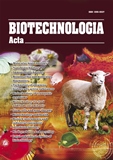ISSN 2410-7751 (Print)
ISSN 2410-776X (Online)

Biotechnologia Acta Т. 18, No. 3, 2025
P. 39-44, Bibliography 6 , Engl.
UDC 577.112.6:615.015.8
doi: https://doi.org/10.15407/biotech18.03.039
HB-EGF AS A TARGETED CARRIER FOR DRUG DELIVERY IN SOME CANCERS
I.I. Gamaliia 1, 2, A.A. Siromolot 1, 2, D.V. Kolybo 2
1 Educational and Scientific Centre «Institute of Biology and Medicine»,
Taras Shevchenko National University of Kyiv, Ukraine
2 Palladin Institute of Biochemistry of the National Academy of Sciences of Ukraine, Kyiv
Cell-penetrating peptides (CPPs) facilitate efficient biomolecule delivery with low immunogenicity and cytotoxicity, making them ideal for in vivo drug delivery. Heparin-binding epidermal growth factor-like growth factor (HB-EGF), a ligand of the epidermal growth factor receptor (EGFR), is overexpressed in tumors and can promote angiogenesis. Doxorubicin (DOX), a chemotherapeutic, treats various cancers but has limited use with HB-EGF as a carrier.
Aim. In this study we focused on the HB-EGF’s potential in enhancing DOX delivery and antitumor effects.
Methods. Recombinant sHB-EGF was expressed in E. coli, purified by IMAC, and loaded with DOX with further dialysis of the complex from unbound antibiotics. Binding to cell surfaces (A431, 3T3, Vero), as well as ROS production using DCFH-DA, were analyzed by flow cytometry. Cell viability was assessed with MTT assays after 48 h.
Results: sHB-EGF fluorescent derivatives effectively bound to A431 cells, enhancing DOX delivery to squamous-cell carcinoma and significantly reducing cell viability.
Conclusions: HB-EGF efficiently delivers DOX into cells, suggesting its potential as a targeted drug carrier for EGFR/ErbB-1 overexpressed cancers.
Keywords: targeted drug delivery, sHB-EGF, doxorubicin, EGFR, cancer therapy.
© Palladin Institute of Biochemistry of the National Academy of Sciences of Ukraine, 2025
References
1. Luo, Z., Cao, X. W., Li, C., Wu, M. D., Yang, X. Z., Zhao, J., Wang, F. J. (2016). The heparin-binding domain of HB-EGF as an efficient cell-penetrating peptide for drug delivery. Journal of peptide science, 22(11–12), 689–699.https://doi.org/10.1002/psc.2932
2. Van Hiep, N., Sun, W. L., Feng, P. H., Lin, C. W., Chen, K. Y., Luo, C. S., Dung, L. N., Van Quyet, H., Wu, S. M., Lee, K. Y. (2022). Heparin binding epidermal growth factor-like growth factor is a prognostic marker correlated with levels of macrophages infiltrated in lung adenocarcinoma. Frontiers in oncology, 12, 963896. https://doi.org/10.3389/fonc.2022.963896
3. Maltas, E., Gubbuk, I. H., Yildiz, S. (2016). Development of doxorubicin loading platform based albumin-sporopollenin as drug carrier. Biochemistry and biophysics reports, 7 , 201–205. https://doi.org/10.1016/j.bbrep.2016.06.012
4. Kciuk, M., Gielecińska, A., Mujwar, S., Kołat, D., Kałuzińska-Kołat, Ż., Celik, I.,
Kontek, R. (2023). Doxorubicin-An Agent with Multiple Mechanisms of Anticancer
Activity. Cells, 12(4), 659. https://doi.org/10.3390/cells12040659
5. Linders, A.N., Dias, I.B., López Fernández, T., Tocchetti, C.G., Bomer, N., Van der Meer, P. (2024). A review of the pathophysiological mechanisms of doxorubicin-induced cardiotoxicity and aging. npj Aging, 10, 9. https://doi.org/10.1038/s41514-024-00135-7
6. Ai, S., Duan, J., Liu, X., Bock, S., Tian, Y., Huang, Z. (2011). Biological evaluation
of a novel doxorubicin-peptide conjugate for targeted delivery to EGF receptoroverexpressing tumor cells. Molecular pharmaceutics, 8(2), 375–386. https://doi. org/10.1021/mp100243j

